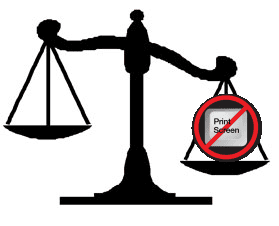by John Patzakis
In recent months, courts in several reported decisions have excluded evidence in the form of screen captures of social media. These court decisions greatly impacted the overall matter, including directly resulting in the overturning of a criminal conviction.  This is a very important trend as many criminal investigators and litigation support practitioners continue to rely on print screen without realizing the now torrent level of case law disallowing such evidence.
This is a very important trend as many criminal investigators and litigation support practitioners continue to rely on print screen without realizing the now torrent level of case law disallowing such evidence.
In the most recent example, in Moroccanoil vs. Marc Anthony Cosmetics, — F.Supp.3d —- (2014) a federal district court explicitly ruled that Facebook screenshots were inadmissible as the defendant in a trademark infringement action merely offered the screenshots without supporting circumstantial information, which is difficult to obtain when mere screenshots are relied upon. The Moroccanoil court cited Internet Specialties W., Inc. v. ISPWest, 2006 WL 4568796 which in that case ruled: “Defendant’s argument, that [web pages] could be ‘authenticated’ by the person who went to the website and printed out the home page, is unavailing.” The Moroccanoil court applied the same rule to Facebook screenshots.
In the criminal context, in United States vs. Vayner, 2014 WL 4942227 (C.A. 2 (N.Y.)), A US Federal Appellate Court, Second Circuit, recently overturned a criminal conviction upon finding that the lower court erroneously admitted a screenshot of the defendant’s alleged social media profile due to improper authentication. Earlier this year, in Commonwealth v. Banas, 2014 WL 1096140 a Massachusetts Appellate Court also ruled that a screen print of Facebook post submitted by the prosecution in a criminal case to be inadmissible on authentication grounds.
The courts that produced these decisions are very influential and these decisions will impact standards for, and the scrutiny of, all social media evidence collection in criminal and civil matters nationwide.
(As a side note, these recent decisions and other key issues involving social media evidence will be discussed at length in a December 16 webinar featuring computer forensics expert Craig Ball and Reed Smith eDiscovery counsel Patrick Burke: A Practical Approach to Social Media Discovery. The top-line speakers will cover the importance of social media discovery in today’s cases, recent challenges and best practices. The event is one week away as of this writing but — as a testament to this compelling and timely topic — we have nearly 600 registrants and seats are limited, so I encourage you to register now.)
The cases cited above and many others like them illustrate that social media provides torrential amounts of evidence potentially relevant to litigation matters, with courts routinely facing proffers of data preserved from various social media websites. One of the many benefits of X1 Social Discovery is its ability to preserve and display all the available circumstantial evidence in order to present the best case possible for the authenticity of social media evidence collected with the software. This includes collecting all available metadata and generating a MD5 checksum or “hash value” of the preserved data for verification of the integrity of the evidence. It is important to collect and preserve social media posts and general web pages in a thorough manner with best-practices technology specifically designed for litigation purposes. For instance, there are over twenty unique metadata fields associated with individual Facebook posts and messages. Any one of those entries, or a combination of them contrasted with other entries, can provide unique circumstantial evidence that can establish foundational proof of authorship. (We identify the nearly two dozen fields of unique Twitter metadata in our white paper available here).
Additionally, when an examiner merely relies on print screen, they also severely limit the scope and thoroughness of the social media and internet collection. Employing more automated means, such as X1 Social Discovery, enables the examiner to quickly collect entire web pages and publically available social media accounts, which can be hundreds of pages long. This allows the examiner to build a much stronger case for authentication by building timelines, drawing more connections between witnesses and their various posts, collecting more collaborating metadata, and a litany of other means to build a compelling circumstantial case to authenticate the social media or web page evidence in question.
So in sum, you can either have your cake and eat it too with X1, or incur much higher costs, overlook mountains of potentially case-winning evidence, arguably violate your ethical duty of competence, and face evidentiary challenges in court with print screen. Seems like an easy decision.
